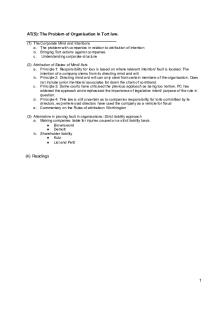The Alcock test - Tort Law Directions PDF

| Title | The Alcock test - Tort Law Directions |
|---|---|
| Course | Tort |
| Institution | University of Chester |
| Pages | 3 |
| File Size | 50.1 KB |
| File Type | |
| Total Downloads | 85 |
| Total Views | 148 |
Summary
This document provides: The Alcock test supported by the relevant case and its 4 principles....
Description
The Alcock test
Alcock v Chief Constable of South Yorkshire (1992)
The Hillsborough football stadium disaster was referred to earlier in the discussion of the policy concerns about floodgates. In 1989, ninety-six football supporters were killed and another 400 injured in the spectator stands when crowd control broke down and barriers collapsed at the beginning of an FA Cup match between Liverpool and Nottingham Forest. The ensuing crush was horrifying for those caught up in it but also for those watching: both thousands at the match and millions more at home on television. The main cause of the tragedy was the admitted negligence of the police, for which the Chief Constable was vicariously liable and it gave rise to a number of negligence claims which were simply settled. There were, however, other claims in which liability was disputed on the grounds that the police owed no duty to the plaintiffs in respect of the kind of damage which they suffered.
In Alcock v Chief Constable of the South Yorkshire, the plaintiffs were some fifteen relatives of those caught up in the crush, who all suffered psychiatric illness as a result of what they experienced that day. None had been in any physical danger themselves: all were secondary victims. The legal problem for them lay in the fact that for each plaintiff there was a lack of closeness, either to the event or to the victims themselves. For example, Mr and Mrs Copoc lost their son, but they were not at the ground and watched the event on the television, identifying his body the next day. Because they experienced the event through the medium of television, their claim lacked proximity in time and space. Another plaintiff, Robert Alcock, was at the
match and was a direct eyewitness to the event’s unfolding but the victim he feared for was his brother-in-law, a relationship which is considered less close than, say, parent–child. The House of Lords held that none of the plaintiffs could recover.
Alcock has been said to have laid down three key requirements, all of which must be satisfied in order to establish the foreseeability necessary for the existence of a duty of care to a secondary victim:
1. A sufficiently close relationship of love and affection with the primary victim. This will be presumed to exist between a husband and wife and parents and children; those in other relationships will have to convince the court. Shock in a mere bystander, such as Mrs Bourhill, will not be foreseeable.
2. Proximity to the accident, or its immediate aftermath, which was sufficiently close in time and space. Seeing bodies in the mortuary for the purpose of identification, some nine hours after the event was held not to be sufficiently proximate in Alcock.
3. Suffering nervous shock through what was seen or heard of the accident or its immediate aftermath, or as Lord Ackner put it, ‘sudden appreciation by sight or sound of a horrifying event which violently agitated the mind’. What is seen on television, or told by someone else, is not immediate enough.
4. An additional fundamental requirement must always be included: that of a sudden and shocking event, discussed above....
Similar Free PDFs

12. Nuisance - Tort Law Directions
- 22 Pages

Revision - Tort - Tort Law
- 32 Pages

TORT LAW Revision - Summary Tort Law
- 25 Pages

Cases - Tort law
- 4 Pages

Tort Law Lecture 5
- 3 Pages

Tort Law- Lecture 16
- 5 Pages

Tort law cases
- 6 Pages
Popular Institutions
- Tinajero National High School - Annex
- Politeknik Caltex Riau
- Yokohama City University
- SGT University
- University of Al-Qadisiyah
- Divine Word College of Vigan
- Techniek College Rotterdam
- Universidade de Santiago
- Universiti Teknologi MARA Cawangan Johor Kampus Pasir Gudang
- Poltekkes Kemenkes Yogyakarta
- Baguio City National High School
- Colegio san marcos
- preparatoria uno
- Centro de Bachillerato Tecnológico Industrial y de Servicios No. 107
- Dalian Maritime University
- Quang Trung Secondary School
- Colegio Tecnológico en Informática
- Corporación Regional de Educación Superior
- Grupo CEDVA
- Dar Al Uloom University
- Centro de Estudios Preuniversitarios de la Universidad Nacional de Ingeniería
- 上智大学
- Aakash International School, Nuna Majara
- San Felipe Neri Catholic School
- Kang Chiao International School - New Taipei City
- Misamis Occidental National High School
- Institución Educativa Escuela Normal Juan Ladrilleros
- Kolehiyo ng Pantukan
- Batanes State College
- Instituto Continental
- Sekolah Menengah Kejuruan Kesehatan Kaltara (Tarakan)
- Colegio de La Inmaculada Concepcion - Cebu








